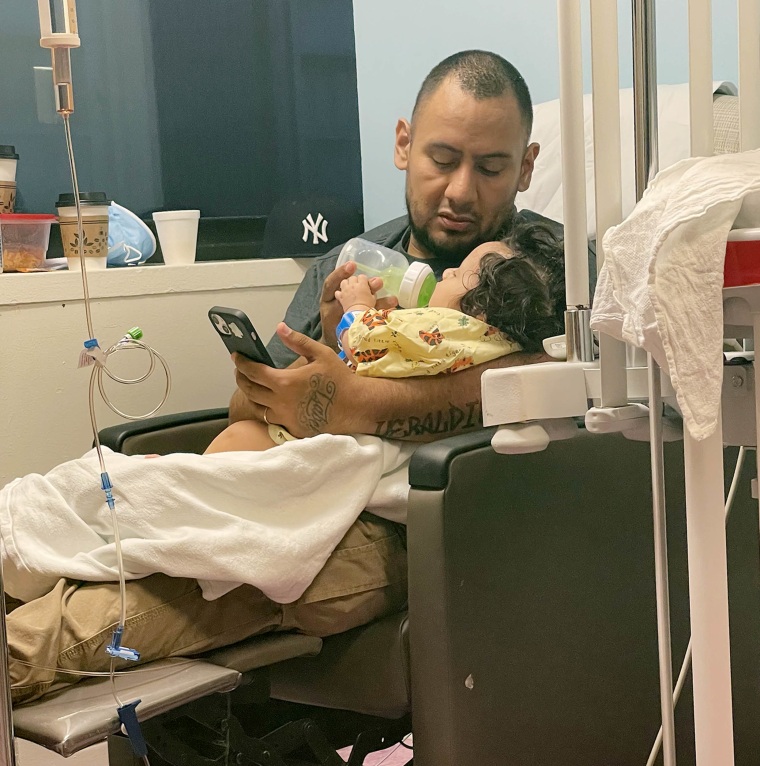When Faustina Cavero, 31, first saw her baby make an odd gesture, she thought she must have scared her when picking her up.
The nearly 5-month-old's arms would stretch and stiffen. She made faces like she was trying to grit her teeth even though she didn't have teeth yet, Cavero tells TODAY.com. And she would cry in between spasms.
As the strange movement patterns became more frequent, they also became more distressing for Cavero, a stay-at-home mom living in New York City. She took her baby, Aaliyah, to a hospital to get checked out, but was dismissed — twice, Cavero says.
"They told me I was a new mom and, 'Maybe you're just tired. You need to get some rest. The baby's fine,'" she recalls. Cavero, who has three other children between the ages of 7 and 13, wasn't new to being a mom. But she decided to let it go for the time being.
However, Aaliyah "kept constantly doing the movements, and it kept getting worse and worse," Cavero says. "It got to the point where she kept crying," she says, which is when Cavero and her husband took baby Aaliyah to another hospital.
Again, she explained what she'd seen and even showed the staff videos of Aaliyah's odd gestures. But again, Cavero's concerns were dismissed as unnecessary worries from a tired, stressed out mom.
After being dismissed twice, finally an answer
"This is the second time I've taken her to the hospital, and it's the second time they've told me that she's fine and there's something wrong with me," Cavero recalls. "Meanwhile, I know there's something wrong with our baby."
That night, Cavero's mother saw the odd movements for herself, looked online for possible causes and urged the parents to keep pushing. By then, Aaliyah's gestures were getting more severe — her eyes started rolling back and she'd stopped smiling.
So Cavero and her husband resolved to try once again to get a diagnosis, taking the first neurology appointment they could reserve online.
The next day, Cavero took baby Aaliyah to the appointment with Dr. Natasha Acosta Diaz, a pediatric neurologist at Mount Sinai Kravis Children’s Hospital.
Although Acosta Diaz couldn't give an exact diagnosis without further testing, she had a pretty good idea of what was going on after seeing Cavero's videos. "It's an easy diagnosis for any neurologist that sees the videos," Acosta Diaz says.
Suspecting that Aaliyah was exhibiting infantile spasms, she rushed to admit the baby directly to the pediatric epilepsy unit at Mount Sinai Kravis Children’s Hospital. Acosta Diaz walked Aaliyah there herself, handing her off to Toni Kavanagh, a registered nurse and clinical specialist in pediatric neurology at the hospital.
In the epilepsy monitoring unit, Aaliyah's brain waves were monitored with EEG testing, which measures electrical activity in the brain. Within the first 30 minutes, "already the patient had an abnormal background (reading)," Dr. Maite La Vega-Talbott, interim director of the pediatric epilepsy monitoring unit at Mount Sinai Kravis Children’s Hospital, tells TODAY.com.
That, along with a long list of tests to rule out other conditions, helped confirm the diagnosis of infantile spasms, also called West Syndrome.

What are infantile spasms?
The spasms are actually seizures. They are a form of epilepsy that tends to occur between the first 4 and 8 months of a baby’s life, according to the National Institute of Neurological Disorders and Stroke.
The movements, which only last a few seconds at most, typically come in clusters. During one of the seizures, a baby may arch their back and stiffen momentarily. It might look like the baby is gritting their teeth, even if they don't have any.
The spasms tend to occur more frequently when the baby is transitioning between wakefulness and sleep, which was the case for Aaliyah, who typically had seizures after nap time, Acosta Diaz adds.
Infantile spasms can be caused by different underlying issues. And, depending on the cause, they may go away completely after age 4 or 5 — or the child may develop neurological impairments or other types of seizure disorders, NINDS explains. Getting diagnosed and treated quickly can improve the chances for better outcomes down the line, the experts tell TODAY.com.
For the best chance of positive outcomes, the treatment for infantile spasms needs to be administered as quickly as possible. So an abnormal EEG reading like Aaliyah had “puts the ball in motion,” says La Vega-Talbott, who is also an assistant professor of neurology and pediatrics at the Icahn School of Medicine at Mount Sinai.
First, babies with infantile spasms receive a medication called adrenocorticotrophic hormone, a corticosteroid, which is injected into the muscle. It works quickly to drastically reduce the number of seizures a baby has, but it's only used temporarily for 30 days, La Vega-Talbott explains.
It begins to work within two to three days, and the patient typically stops having seizures within five days, she says. "After a week or two, the parents can start seeing their kid is a little more interactive, has better eye contact and that smile that is lost is coming back slowly." After that initial treatment, the baby receives a more typical anti-seizure medication for months or longer while undergoing EEG monitoring to keep track of their symptoms.
Seeing her baby in the hospital brought a mix of complicated emotions for Cavero. She felt blessed to finally have some answers and be taken seriously, but it was tough to watch her child go through something like this.
"She kept crying and she was still small," Cavero recalls, adding that doctors had trouble finding her veins. Cavero remembers sitting in a corner of the room, "telling myself, 'I want to die, please God, take me, not my baby."
La Vega-Talbott comforted Cavero. "She told me, 'Listen, we're doing all we can to help your baby, and she's going to be fine. Believe me, we're doing what's best for her,'" Cavero recalls. From there, she began to feel more comfortable and watched as doctors started administering the medication that would help get Aaliyah's seizures under control.
More than a year later, no more seizures
Today, Aaliyah is nearly 2 years old, and "she is actually doing what a normal 2-year-old is supposed to do," Cavero says. She's a little behind on speech development, but after her latest EEG, "the doctor said that she is 95% great, so I'm just thankful for that."
Cavero hopes Aaliyah's last EEG was at the beginning of September and that she'll soon be able to take a lower dose of medication or stop completely as her symptoms have improved so much. And although it's possible the seizures could come back one day, "at least we know now what she has and we'll be ready for it," Cavero says.
Looking back on her journey to get a diagnosis, Cavero says she simply trusted her gut. And she encourages others not to give up if they know, deep down, that something isn't right. "Trust your instincts and keep going," she says.
